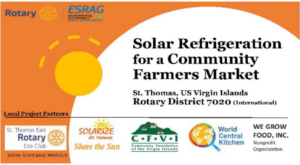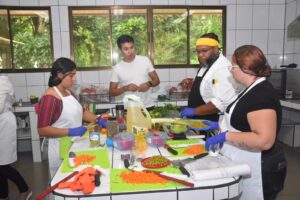Insights from Keith Madden, The Rotary Foundation Manager for the Environment
By Ariel Miller, ESRAG Newsletter Editor
We’re delighted to provide an update on Rotary’s expanding environmental action, thanks to Keith Madden, The Rotary Foundation (TRF) Manager for the Environment Area of Focus, who spoke to the Network of Rotary Eco and Environment Clubs on Nov. 7, 2023. He explained how Rotary’s environment area of focus is evolving and how you can increase your project’s likelihood of winning a Rotary environmental global grant.

St. Thomas East Eco Rotary’s solar project for a farmer’s market in the US VIrgin Islands combined resilience, greenhouse gas reduction, and community economic development. This is the opening slide of Rotarian Doug White’s presentation to ESRAG about the highly successful global grant project.
Madden offered advice on how to develop successful projects to qualify for global grants. He celebrated how Rotary’s capacity for effective environmental action is growing with the help of Rotarians on the front lines, such as ECO Cubs around the world. Members of 19 Rotary and Rotaract Clubs from eight countries and four continents took part in this lively and informative session organized by Steve Solbrack of Twin Cities Rotary EcoClub, Minnesota, US.
Madden, who brings years of conservation experience to his Rotary role, is working to train colleagues at The Rotary Foundation on environmental sustainability. He encourages ESRAG and Eco club members to “be vocal and well-connected to Rotary leadership to get these topics on the agenda at conventions” such as the Zone Institutes, PETS, and District Conferences.
He highlighted four themes in his Nov. 7 talk:
- Adaptive management: Rotarians and TRF are learning and building their capacity to increase Rotary’s impact on environmental challenges.
- Integrating environmental sustainability into Rotary’s other Areas of Focus.
- Leveraging Rotary’s strengths – particularly for developing community-based, community-run solutions, and our ability to work at the local, regional, and global level.
- The vital importance of documenting baseline conditions and aiming for specific and measurable improvements.
He also fielded questions and offered tips to increase a global grant proposal’s likelihood of being funded.
Adaptive Management: Rotary International’s leaders unanimously approved environmental sustainability as an Area of Focus in 2020, building on the momentum of work that Rotarians had already been doing, but elevating action on the world’s huge environmental problems to be one of Rotary’s top priorities.
“It is important that Rotary recognized the scale of the challenges and is allowing us to innovate,” said Madden. That requires paying attention to “what’s happening in the world and within Rotary.” While Rotarians “have the most flexibility in local and district projects, global grant policy is flexible also,” he added.
Rotary, he explained, is building four strategic pillars for the future:
- Nature-based solutions
- Freshwater conservation
- Sustainable land use, and
- Environmental human rights dialogue
These categories mirror the dynamic discussions going on in ESRAG’s chapters and task forces worldwide on the growing havoc caused to human communities by biodiversity loss, climate change, and pollution. Impacts like heat, storms, drought, and depleted soils and aquifers imperil food security and livelihoods all over the world.

RETUS is a woman-run eco-tourism enterprise to protect the cloud forest in Costa Rica. The project, which combines community economic development and biodiversity, has won four Rotary Global Grants and has been featured in Rotary Magazine. In this picture, international and host club colleagues Chef Aundre Blasingame (RC Arlington Sunrise, Texas, US) and Rotaractor Joshua Cespedes (RC Cartago, Costa Rica) teach rural Costa Rican women food prep skills as they prepare for their certifications to be restaurant owners.
Integrating environmental sustainability into projects in the other Areas of Focus: “The Area of Focus is broad and accommodates a lot of interests,” Madden said. Rotary’s environmental goals support the UN Sustainable Development Goals and are vital to the success of work under Rotary’s other Areas of Focus, such as Water and Sanitation, Community Economic Development, and Peace. He listed four overarching objectives for Rotary’s environmental projects:
- Nature and biodiversity conservation
- Sustainable livelihoods
- Climate mitigation, and
- Environmental equity
Madden alerted us that TRF staff are working on Foundation-wide initiatives and developing indicators for TRF initiatives that align with the Sustainable Development Goals. “We’re trying to infuse pro-environmental activities across all programs and grants,” he said. To that end, he’s providing training to The Rotary Foundation on how to add environmental sustainability to the planning and evaluation of all global grant proposals. For example, community economic development depends on fertile soil and sufficient supplies of fresh water. Peace will prevail if people can work and thrive where they live, rather than being driven by drought or disaster or resource conflicts to fight or flee.
Leveraging Rotary’s strengths: Madden sees the fact that our Clubs are community-based as a great asset, as Rotary starts to partner with other major stakeholders to tackle environmental problems. To achieve enduring impact, projects such as solar generation need to be community-based and community-run. TRF’s requirement for a community needs assessment is vital to durable impact. Rotary clubs – because they are local – are ideally placed to convene community members to analyze the situation, set goals, and shape successful projects. Another strength is Rotary’s multiple ways of working: that we know how to design and implement projects at local, regional, and global levels.
It’s powerful that environmental human rights and equity are part of Rotary’s objectives.
Rotarians’ love of our communities and deep connections to their wellbeing put us in a perfect place to bear witness to the unfairness of the burdens pollution and climate change place on those with the least financial and material resources to adapt. We can shed the light of the Four-Way Test on injustices like the fatal synergy of last year’s melting glaciers and giant monsoons that flooded a third of Pakistan, a country responsible for only a tiny fraction of the world’s greenhouse gas emissions.
Documenting baseline conditions and aiming for specific, measurable improvements: To succeed, Madden stressed that global grant proposals need to describe what the baseline conditions are. What emissions are occurring – for example, from diesel fuel consumption by a hospital generator or a fleet of auto-rickshaws? How will your project change that, and how will you measure the change?
“The scale of the project is less important than the ability to show real impact, say from a pollinator garden,” he explained. Proving impact will build confidence.
Many grant proposals ask for funds for equipment without also including training and other built-in steps to ensure that the community understands and can maintain the project technically and financially. “The goal is durability,” he said. “No question that Rotary should be part of getting solar generation out there in the world – and quickly – but can the community replace the solar panels at the end of their useful life?”
Common pitfalls in proposals: Keith Madden listed several oversights that prevent environmental projects from getting approved:
- Lack of clarity about the objectives: many proposals describe a problem but not the goals for change, plus a logical explanation of how to achieve them.
- Lack of transparency in budgets: too much is lumped into a few line items. Add detail about the inputs and costs.
- Sometimes environmental projects are submitted under other Areas of Focus.
Funding: Madden shared graphs and fielded questions about TRF global grant funding. Donations for environmental work are robust: many donors seem to have been waiting eagerly for this priority. Grants grew from USD $1.9 million in 2021-22 to USD $3.3 million in 2022-23 and are on track to reach USD $3.5-$5 million this year.
Districts vary greatly in the amount of District-Designated Funds they have, so that’s a factor weighting the geographic distribution of grant dollars. But overall, he said, grant allocations are “very fluid from year to year: there is no TRF cap or floor by Area of Focus, though donors do have an influence through restricted gifts.”
How you can encourage and equip action: Echoing what ESRAG Director Mina Venkataraman said in her November, 2023 article, Madden urged Rotarians with environmental expertise to join Rotary’s Cadre to help clubs develop successful global grant projects. He also urged Rotarians on the front lines to advocate with Rotary leadership for environmental action. Another smart step will be to showcase Rotaractors’ environmental projects in contests!

